When: Tuesday, 4, December, 2018
Time: 6:00pm -8:00pm
Where:
Leichhardt Library
Piazza Level -Italian Forum, 23 Norton St
Leichhardt NSW

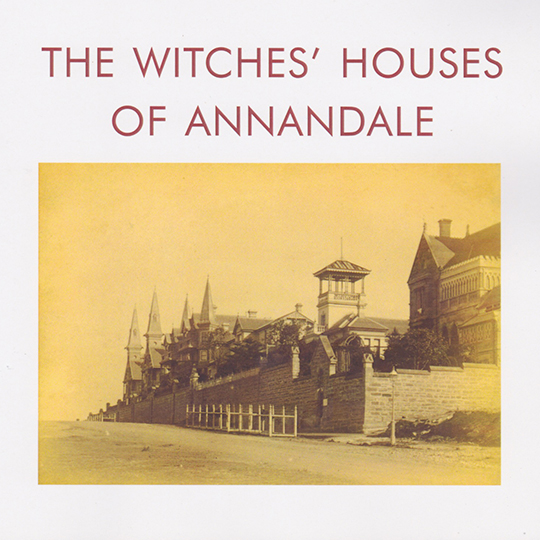
Leichhardt Library
Piazza Level -Italian Forum, 23 Norton St
Leichhardt NSW
Do you have any photographs from the past of Annandale, Leichhardt, Balmain, Rozelle, Marrickville, or Ashfield. As part of History week 2016 we will be inviting you all to share your memories of the Lost local. In September 2016 we invite you all to write down captions of memories on our memory bubbles and pin it to the history pinboard at the library….we want your shots of places people and events from the iconic to the ordinary.
Email:localhistory@lmc.nsw.gov.au

Looking Down Norton Street to Parramatta Road 1983
We have had a brilliant Heritage Festival for 2014 with three walking tours two author talks and two exhibitions with over 700 visitors to events. Jason Chatwin led a group of 30 on an engaging Historical walk around Bicentennial Park, The Crescent and Jubilee Park. Perfect Autumn weather and a journey from the early beginnings of Annandale, Sir John Young, the crescent and early industry to the later Industrial phase of Rozelle Bay with Timber yards and ship industry to the reclamation of the park after the very effective “Save Rozelle Bay Campaign” in the 1980s. With rich historical resources made available through TROVE our online catalogue WEBOPAC and Online resources some amazing historical information can be found. Keep posted for more walking Tours later on in the year.
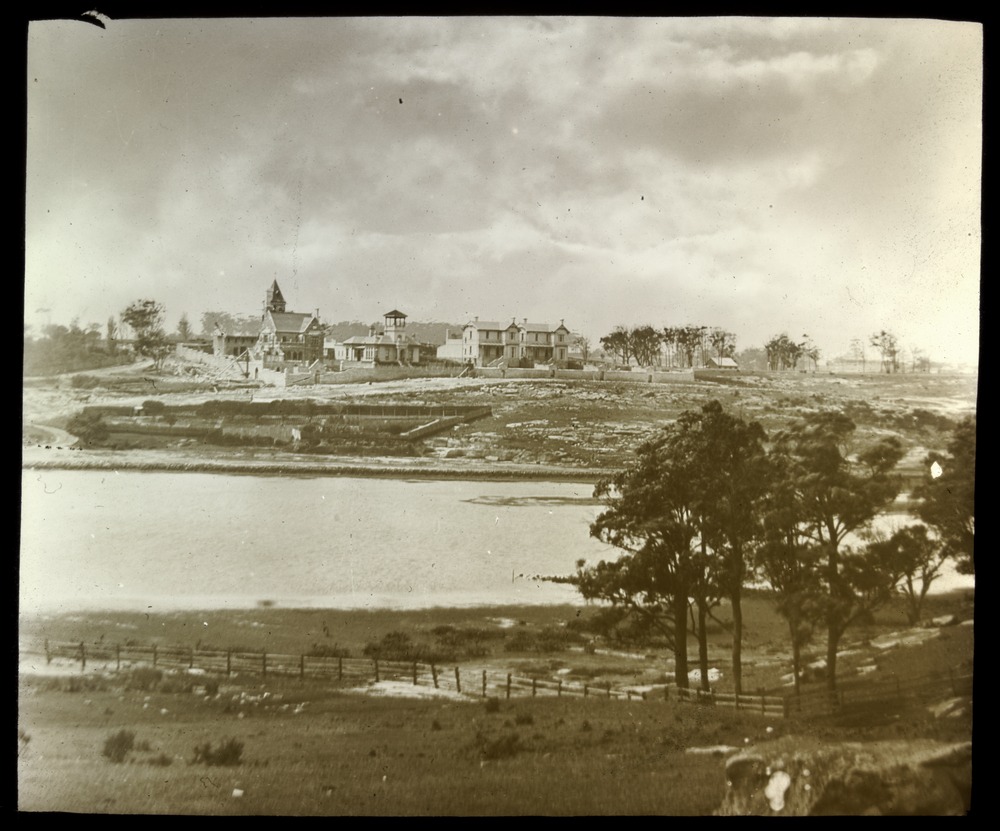
Johnstone St. Nth. Annandale, Sydney, in 1883 looking across Rozelle Bay. Toxeth house in the distance.
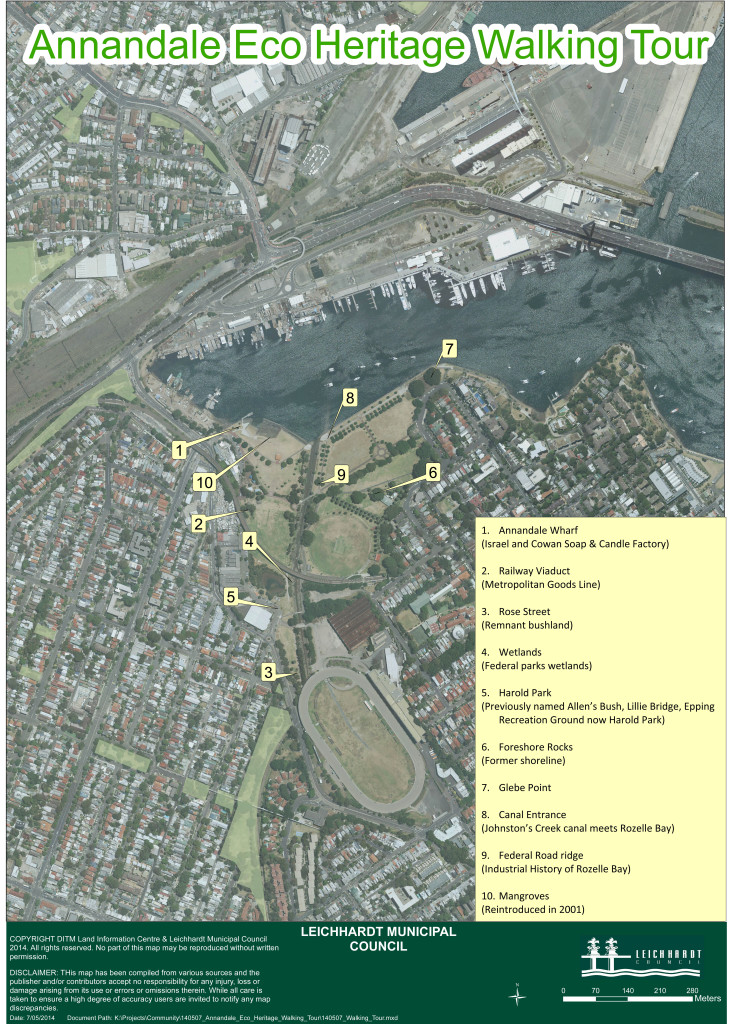
Annandale in re focus…alot of exciting research is under way in regards to Annandale’s history, from indigenous beginnings to early land grants and development. Keep posted for the first two editions of AURA (Annanadale Urban Research Association) journals to be released as an ebook early next year. Strong Women and subdivisions are common themes in the history of Annandale, according to local architect David Springett. Annandale is a unique suburb within this LGA because it was a single block of land until the 1880s with alot of the development taking place from 1890 onwards. The land was first owned by George Johnston midshipmanon the First Fleet, leader of the Rum rebellion, soldier in the Napoleonic wars. He was married to Esther Abrahams, a young Jewish convict and they had four children together, none of who went on to inherent land. The land was left to run down from the 1840s until Melbourne developer Robert Young purchased it in the 1870s. Young subdivided the land and held a competition to plan the new suburb won by Glebe architect Ferdinand Reuss. Although the plan was for the suburb to become one of the finest-in the colony, the lots were re-subdivided and the rate of purchase was lower than expected. During World War I and II the suburb was largely considered a slum, but experienced a resurgence in the 1950s to 1960s. “It is a unique suburb because it was built in a few years.” “David Springett”
References: Local History Vertical Files.
Exciting News !!!!!
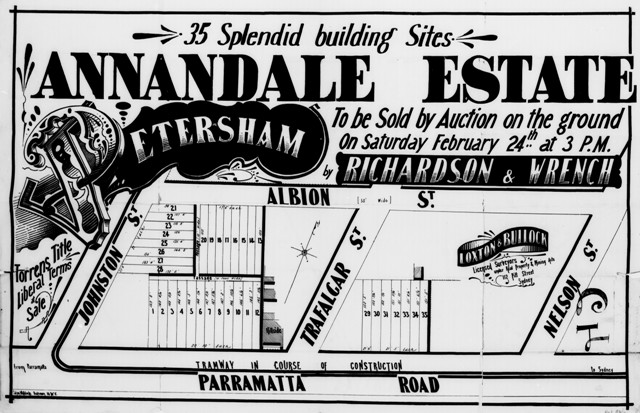
Just select “Anywhere” and type in “Subdivision Plans” or “Sale Plans”
You can now search our library Webopac for Subdivision Plans just type in “Subdivision plans” or your street name and look to the right hand column for Subdivision plans.
Beale’s Piano Factory was historically renowned as the Largest Piano Factory in the British Empire.
Beale and Company were the largest producer of pianos in Australia from the 1890’s through to the early 1960s. Being a Sydney based firm they are of particular significance to the museum’s musical instrument collection which has a strong emphasis on Australian made keyboards including the earliest surviving Australian made piano by John Benham of Sydney dating from about 1835 through to the state of the art Stuart and Sons concert grand piano made in 1998-1999. The Beale company was established by Octavius Charles Beale in 1879 and did not begin manufacturing pianos in Australia until 1893. They later opened a large factory in the Sydney suburb of Annandale in 1902 which was heralded in the Sydney Mail as “a notable step in the march of industrial progress” (18/1/1902 p.166) and was opened by the then Prime Minister, Sir Edmund Barton. OC Beale was a strong advocate of protection of Australian industry and this in part contributed to Beale being able to manufacture pianos successfully, unhindered by foreign competition especially from Germany and the USA. Beale was a vigorous member and President of the Federated Chamber of Manufactures of Australia, the NSW Chamber of Manufactures and the Chambers of Commerce of the Commonwealth of Australia. The Beale Company prided itself on making Australian made pianos for Australian conditions, and to this end took out a patent in 1902 for a tuning pin locking system with a metal wrest plank that aimed to prevent the strings from going out of tune given the humidity and temperature fluctuations of the Australian climate. The company existed until the early 1960s when they were taken over and their local production ceased.
Michael Lea Curator, music & musical instruments.
Piano Making (c.1924) – Film clip of Piano making from Australian Screen.
The Queen Victoria Maternity home once operated out of 61 Albion Street, Annandale. It opened in 1895 for unmarried mothers for whom no charge was made. Matron Attenborough took charge in 1896 and remained their until 1924. The building was left to the Presbyterian Church in 1926 when George Lewis the founder of the hospital died. The number of inmates varied from eight and six beds the six bed ward being for waiting patients. A report in 1929 stated that 300 children were born at the hospital each year.
A ladies auxiliary of the hospital was formed in in 1952 by Mrs Hope Figtree. The auxiliary devoted its time and talents to serving the hospital in many ways including gifts to the board of considerable amounts of money for the reduction of capital debts before the Hospital came under the Hospital Commission.
In 1979 community groups were negotiating to open up Queen Victoria hospital in Annandale for emergency accommodation at the time it was vacant whilst the NSW health commission and the Presbyterian Church were negotiating it’s return to the church. The building contained a cottage, a flat, a flatette, more than 30 bedrooms, nine large rooms and about eight offices.
Architectural Information: is thought that the central block (with rear wings) was built c.1845. the building has been greatly added to throughout the century. It was called “Macquarie Lodge” and after the Johnstons sold Annandale it was occupied by Sidney Smith, M.L.A. It is listed with the National Trust of Australia, it’s significance lying in the fact that it is one of the oldest buildings in the whole Municipality and the only Georgian building of the Johnston era still standing in Annandale.
References: Leichhardt Local History Vertical files
Annandale Association Buildings Register
In August 2010 The Inner West Courier featured a story dedicated to Rodney Monk’s much loved and well known Mural at The Crescent. Never has a man received as much attention from truck drivers as when Rodney Monk posed in front of the 30 yr old mural he painted in 1980. The sprawling mural at The crescent has been described as “the peoples mural.”
It has provided a colourful backdrop for Annandale residents and commuters passing the crescent daily for the last 30 years. The work was commissioned in 1980 and is packed with political messages and acts as a snapshot of the era. Bruce Lay explores the mural which was evidentally in poor condition so so in 2003 Leichhardt Council allocated $10,000 and it was re-painted in 2003/2004 with Rodney Monk invited to tender to consider the involvement of other artist.
Many of the symbols and consensual expression of the concerns and issues that were originally represented in the mural are concerns and values that remain strongly held today, in light of which it has been well respected and cared for over the years with minimal tagging and alteration.
Leichhardt Council has deemed the work so socially significant it has supported a study into it’s history which has been completed by Bruce Lay of Heritage Solutions. Bruce Lay explores the social and political history of murals and Public art in the Whitlam era with a acute focus on the Annandale Mural.
“‘The Mural in The Crescent was the community activism spurred by key events such as opposition to the Vietnam War and the sacking of the Whitlam government, but also social movements around personal liberation including sexuality, gender, racism and ethnicity, and the self- expression of alternative lifestyles and cultural activities.” (Lay 2010) Please find the full study in the link below.
Annandale is one of Sydney’s oldest suburbs, steeped in history with the original land grant given to Lieut.Col. to George Johnston in 1793. Developed mainly between 1870 and 1913, it was a model town, there was even a competition to design it. This planning led to a number of wide open streets in the suburb, a rarity in most inner city areas. There was a time towards the end of the last century when to have a Johnston Street address was to see yourself well up on the social ladder. Johnston Street is one of the widest and most impressive in Sydney, named after George Johnston, solider and “first fleeter” who joined the notorious NSW Corps and rose rapidly through the ranks.
In August this year Annandale Public school located at 25 Johnston Street, will celebrate it’s 125th anniversary which opened on the 31st August 1886.
The school-house was originally built of brick upon1 stone foundation’s, and furnished accommodation for about 600 children. It is a plain hut substantial building, and well suited for the requirements of the neighbourhood. The building comprises four large school-rooms, two class- rooms, and a master’s and teachers’ room. It was furnished throughout with the latest appliances, and was well furnished with desks and other school furniture. SMH August 1886
For many years between 1886 – 1920 it was referred to Annandale Superior Public School
The original Sandstone gates of Annandale House were moved to the front of Annandale Public School in 1976.
Annandale Gates
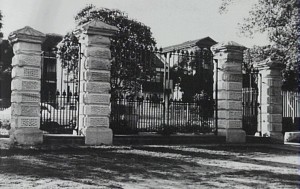
The gates originally stood just off Parramatta Road, on the crest of the hill, on the south side, where the Globe Cinema stood until 1988 and where a row of three businesses including a computer outlet stand today at 192 Parramatta Road. At the centre of each gate hung a cast iron shield featuring the Johnston crest, the flying spur. From the gates an avenue of Norfolk Island pines led south to the house.
Dating the gates is not easy in the absence of documentary evidence, but the impression stylistically that they date from about 1875-1880 is consistent with the changing situation of the Johnston family at that time.The gates had been removed and re-erected at Liverpool showground and subsequently dismantled again. In 1972, they were located by the Annandale Association in storage at Liverpool Council’s depot. Liverpool Council presented the gates to Leichhardt Council in 1972, to commemorate Leichhardt’s municipal centenary. In 1976 it was agreed that they should be included in the landscaping by the Department of Education of the area, now part of the school grounds, where the house “Greyholme” had stood. The Education Department, the school’s headmaster Mr P. Bracks, Leichhardt Council and the Annandale Association agreed to this proposal.
Sources: “Our History” Annandale Public School 1886-1986
Leichhardt Local History Vertical files.
Keep posted for the new publication of Annandale Public School 1886 – 2011 being compiled by the current P&C.
These 1896 Aqueducts were the first structures in Australia to incorporate reinforced concrete using the Monier Patent. They were designed by W. Blatzer to carry the northern main sewer across Johnston’s and White’s Creeks. This new form of construction was investigated by Royal Commission and the contractor.
A bit of Historical Background
In 1859 Sydney had a rudimentary sewage system of five sewers draining to the Harbour and serving an area little larger than what is now the City area. By 1889, this had grown to some 10kim of main sewers and 103 km of subsidiary sewers serving 18,000 properties in the Sydney City area and about 25 km serving 6, 750 properties in the suburbs of Darlington, Paddington and Redfern. The System was controlled by the City Council and continued to discharge to the harbour until 1889 at which time two major projects, initiated by the Government (and constructed by the Public Works Department between 1880 and 1889), were commissioned.
The White’s Creek & Johnston’s creek sewer aqueduct is an original key component of the upstream extension of the BOOS Bondi Ocean Outfall Sewer.
The Aqueducts are listed in with the National Trust for the following reasons –
1. The status of aqueducts as being one of the first two major reinforced concrete structures to be built in NSW, and amongst the first to be built in Australia.
2. The historical significance of the aqueducts as being a key component of the first extension to the Bondi Ocean Outfall Sewer which was completed in 1889 to become the basis of the first of the three major ocean outfall sewers which served Sydney.
3. Its position as being a good example of a significant sewer structure which can be seen. The great majority of any major sewerage system is hidden underground but there are places where crossing gullies, rivers or river flats at which the sewage carrying structures can be viewed, The White’s creek Aqueduct & Johnston’s Creek Aqueduct are such a case.
Information Provided from Leichhardt Library Vertical Files.
IMAGES:
1.Leichhardt Library
2. Sydney Waterboard